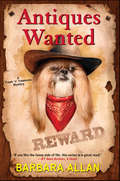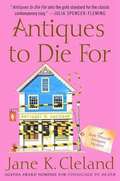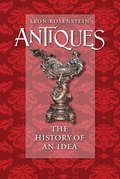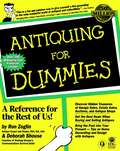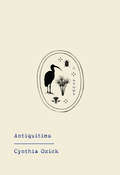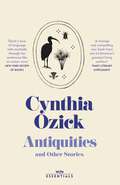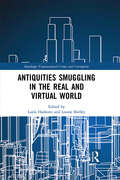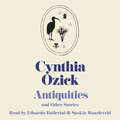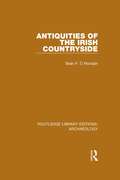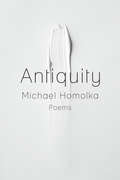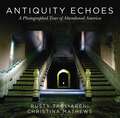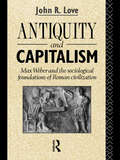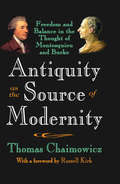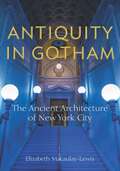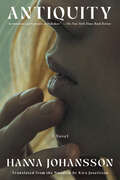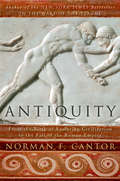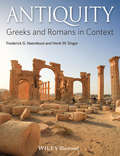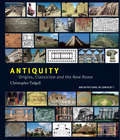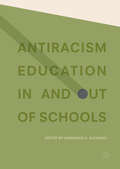- Table View
- List View
Antiques Wanted (A Trash 'n' Treasures Mystery #12)
by Barbara AllanSpring lassos small-town Serenity, as Brandy Borne’s crime-bustin’ mama Vivian hatches a harebrained scheme to run for county sheriff—ropin’ in her daughter to join the rodeo as campaign manager. As the two-woman posse tracks down voters at a local assisted-living home, Brandy’s attempts at corralling Mother’s impractical whims make her feel like a tinhorn on a bucking bronco. But sure as shootin’, unhappy trails lie ahead. . . . Shortly after the Borne gals receive a valuable signed photo of an old-timey cowboy actor from the elderly aunt of Vivian’s political opponent, a massive explosion sends Brandy to the ER and auntie to the grave. With a string of unexplained deaths turning Sunny Meadow into Boot Hill, the ditzy duo—aided by their clever shih tzu Sushi—must lay down the law on a deadly outlaw . . . before someone’s elected the next victim, with the Bornes headin’ toward their last round-up! Don’t miss Brandy Borne’s tips on white elephant sales!
Antiques on the Cheap: A Savvy Dealer's Tips: Buying, Restoring, Selling
by James W. McKenzieGet the inside scoop on every aspect of antiquing - buying, cleaning, repairing, embellishing, refinishing, restoring, and selling. You'll find expert advice for getting great deals at auctions, flea markets, and shops, and you'll learn how to spot items that can be repaired to increase their value. Advice for selling antiques at flea markets, on consignment, and in shops is included.
Antiques to Die For (Josie Prescott #3)
by Jane K. ClelandSince Josie Prescott left a high-paying job in New York to set up shop as an antiques appraiser on the rugged New Hampshire coast, her life has not gone exactly according to plan. In many ways, it's gone better: She has a booming business, good friends and neighbors, and even a promising romance. But dead bodies do seem to keep crossing her path. And now her friend Rosalie has been killed just hours after confiding a secret to Josie, leaving a bereaved twelve-year-old sister, Paige, who reminds Josie of herself when her mother died. It turns out that Rosalie had other secrets too: a mysterious treasure she told her sister she was leaving behind--and a secret admirer who now seems to be turning his creepy attention to Josie! As Josie races to solve the crime while helping Paige and trying to keep her business afloat, Jane K. Cleland brings us an irresistible new blend of coziness, crime, and collectibles.
Antiques: The History of an Idea
by Leon RosensteinThe notion of retrieving a bit of the past-by owning a material piece of it-has always appealed to humans. Often our most prized possessions are those that have had a long history before they came into our hands. Part of the pleasure we gain from the encounter with antiques stems from the palpable age and the assumed (sometimes imaginary) cultural resonances of the particular object. But precisely what is it about these objects that creates this attraction? What common characteristics do they share and why and how do these traits affect us as they do? In Antiques: The History of an Idea, Leon Rosenstein, a distinguished philosopher who has also been an antiques dealer for more than twenty years, offers a sweeping and lively account of the origin and development of the antique as both a cultural concept and an aesthetic category. He shows that the appeal of antiques is multifaceted: it concerns their value as commodities, their age and historical and cultural associations, their uniqueness, their sensuous and tactile values, their beauty. Exploring how the idea of antiques evolved over time, Rosenstein chronicles the history of antique collecting and connoisseurship. He describes changing conceptions of the past in different epochs as evidenced by preservations, restorations, and renascences; examines shifting attitudes toward foreign cultures as revealed in stylistic borrowings and the importation of artifacts; and investigates varying understandings of and meanings assigned to their traits and functions as historical objects.While relying on the past for his evidence, Rosenstein approaches antiques from an entirely original perspective, setting history within a philosophical framework. He begins by providing a working definition of antiques that distinguishes them from other artifacts in general and, more distinctly, both from works of fine art and from the collectible detritus of popular culture. He then establishes a novel set of criteria for determining when an artifact is an antique: ten traits that an object must possess in order to elicit the aesthetic response that is unique to antiques. Concluding with a provocative discussion of the relation between antiques and civilization, this engaging and thought-provoking book helps explain the enduring appeal of owning a piece of the past.
Antiquing For Dummies (For Dummies Ser.)
by Ron Zoglin Deborah Shouse“This is a fun and painless way to give yourself a firm grounding in the wide wonderful world of antiques and collectibles.” Kyle Husfloen, Managing Editor, Antique Trader Weekly and Antique Trader’s Antiques & Collectibles Price Guide Do you love to poke around estate sales and antique shops, but can’t tell the difference between Queen Anne and Queen Victoria furniture? Do you dream of owning that old Oriental rug or Meissen figurine — but worry that the dealer might gouge you on the price? Do you own pieces you think might be valuable — but don’t know where to go for a reliable appraisal? Relax. Antiquing For Dummies answers all your antiquing questions—and more. Whether you’re a beginner or you’ve already gotten your feet wet, this fun, friendly guide will give you the savvy you need to cruise, schmooze, bargain for, and care for antiques with confidence. In no time you’ll be able to: Tell the difference between real antiques and stuff that’s just old Develop an antique hunt plan of attack Select antiques based on the 5 key points of the “RADAR Test” Discover hidden treasures at garages, estate sales, auctions, and shops Get the best deals when buying and selling antiques Decorate with antique glass and porcelain from around the world Clean and care for your precious finds Work an auction—real-time and online Writing with humor and common sense, Ron Zoglin and Deborah Shouse demystify the highfaluting terminology of the antique world. And step-by-step they walk you through all the antiquing essential, including: Different furniture styles and periods of furniture and how to distinguish them Dovetails, nails, and other construction elements that offer clues to a piece’s age Where to go for the best antique bargains — includes tips on how to bid at auctions in person or online All about antique glass, ceramics and silver Integrating antiques into your life at home and at the office Antiquing For Dummies gets you up and running with what you need to know to find, research, and negotiate prices like a pro.
Antiquities
by Cynthia OzickFrom one of our most preeminent writers, a tale that captures the shifting meanings of the past, and how our experience colors those meanings.Lloyd Wilkinson Petrie, one of the seven elderly trustees of the now defunct (for thirty-four years) Temple Academy for Boys, is preparing a memoir of his days at the school, intertwined with the troubling distractions of present events. As he navigates, with faltering recall, between the subtle anti-Semitism that pervaded the school's ethos and his fascination with his own family's heritage--in particular, his illustrious cousin, the renowned archaeologist Sir William Matthew Flinders Petrie--he reconstructs the passions of a childhood encounter with the oddly named Ben-Zion Elefantin, a mystifying older pupil who claims descent from Egypt's Elephantine Island. From this seed emerges one of Cynthia Ozick's most wondrous tales, touched by unsettling irony and the elusive flavor of a Kafka parable, and weaving, in her own distinctive voice, myth and mania, history and illusion.
Antiquities (W&N Essentials)
by Cynthia OzickIn 1949, Lloyd Wilkinson Petrie has returned as a Trustee to live in the long-defunct boarding school that he had attended as a child. There he is preparing a memoir.He writes, with faltering recall, of the subtle anti-Semitism that pervaded the school's ethos and of his fascination with the Egyptian archaeological adventures of his distant cousin, Sir William Matthew Flinders Petrie. Memories return too of the passions of a boyhood friendship with named Ben-Zion Elefantin, a mystifying older pupil who claims descent from Egypt's Elephantine Island.From one of our greatest writers, this is a tale that captures the shifting meanings of the past - one that displays her delight in Jamesian irony and the mythical flavor of a Kafka parable, woven into her own distinct voice.
Antiquities Smuggling in the Real and Virtual World (Routledge Transnational Crime and Corruption)
by Layla HashemiThis book examines the illicit trade in antiquities, a trade which has increased massively following the destruction and looting of ancient Near Eastern sites in the Middle East. Focusing on the distribution networks for looted antiquities, especially the routes to the West, the book considers the dealers and facilitators who are key in getting the objects to market, explores the methods used including online marketplaces and social media sites, analyses demand and buyers, revealing that objects are often available at very affordable prices. It outlines the efforts of law enforcement agencies, including the military, and legal systems to contain the trade. Throughout the book highlights the difficulties of putting a stop to this illicit trade, particularly in a conflict region.
Antiquities and Other Stories (Vintage International Ser.)
by Cynthia OzickFrom one of our most preeminent writers, a tale that captures the shifting meanings of the past and how our experience colors those meanings, now alongside four previously uncollected storiesIn Antiquities, Lloyd Wilkinson Petrie, one of the seven elderly trustees of the now-defunct (for thirty-four years) Temple Academy for Boys, is preparing a memoir of his days at the school, intertwined with the troubling distractions of present events. As he navigates, with faltering recall, between the subtle anti-Semitism that pervaded the school's ethos and his fascination with his own family's heritage--in particular, his illustrious cousin, the renowned archaeologist Sir William Matthew Flinders Petrie--he reconstructs the passions of a childhood encounter with the oddly named Ben-Zion Elefantin, a mystifying older pupil who claims descent from Egypt's Elephantine Island. Included alongside this wondrous tale, touched by unsettling irony and with the elusive flavor of a Kafka parable, are four additional stories in Cynthia Ozick's brilliant, distinctive voice, weaving myth and mania, history and illusion: The Coast of New Zealand, The Bloodline of the Alkanas, Sin, and A Hebrew Sibyl.
Antiquities and Other Stories (W&N Essentials)
by Cynthia Ozick'A writer innately drawn to paradox, and to the moral questions inherent in the relationships between richness and poverty, mind and body, history and imagination' Ali Smith'As cunning and rich as anything Ozick's written' Wall Street Journal'One of our era's central writers. About a man ensnared by history, Antiquities is at once a warning against the hazards of nostalgia and an invitation to take a longer view of how we got to where we are' The New Yorker'Ozick's prose urges the breathless reader along, her love of language rolling excitedly through her sentences like an ocean wave' New York Review of BooksI remember nothing. I remember everything. I believe everything. I believe nothing. In 1949, Lloyd Wilkinson Petrie returns as a Trustee to the long-defunct boarding school that he attended as a child. There he is preparing a memoir about the subtle anti-Semitism that pervaded the school, about his fascination with the Egyptian archaeological adventures of his distant cousin, about the passions of a boyhood friendship with named Ben-Zion Elefantin, a mystifying older pupil.In this novella, and the three stories published alongside it, one of our most preeminent writers weaves together myth and mania, history and illusion to capture the shifting meanings of the past.A W&N Essential
Antiquities of the Irish Countryside (Routledge Library Editions: Archaeology)
by Sean P. O RiordainNo country is as rich in field antiquities as Ireland, and this work gives an account in simple language of the origin, purpose, date and distribution of all classes of monuments with the exception of ecclesiastical remains and medieval castles. It provides the general reader with all the information he is likely to need on such monuments as forts, megalithic tombs, crannogs and stone circles and is an exceptionally useful book for the student. Published in 1979, this fifth edition was thoroughly revised and updated to include more recently discovered sites and new interpretations. Includes map and chronological table.
Antiquity
by Michael Homolka Mary Ruefle"The poems in Antiquity very much abandon themselves to language, to the collective poetic endeavor, and they do so in a rich, textured, and sustained voice."--Mary Ruefle, from the introduction Winner of the Kathryn A. Morton Prize, Michael Homolka's Antiquity offers the present infused with the past, from Ancient Greece to the Holocaust to contemporary battlefields. A haunting and evocative debut. Michael Homolka lives and works in New York City. Homolka's poems have appeared in the New Yorker, Ploughshares, the Threepenny Review, and elsewhere.
Antiquity Echoes: A Photography Tour of Abandoned America
by Rutsy Tagliareni Christina MathewsAntiquity Echoes is a guided tour of some of our nation's most compelling abandoned locations. With a wide spectrum of places covered, readers will be walking the dark halls of an abandoned mental asylum on one page and lost in the overgrowth of an abandoned theme park on the very next. With a focus on history and first-hand accounts by the author, Antiquity Echoes is far more than a collection of photography and text, it's an adventure story. Photographer Rusty Tagliareni spent years traveling the country documenting forlorn locations throughout the United States, sharing his deep passion for history and preservation and what has generated alliances with many historic societies and preservation organizations. What makes a place worth remembering? Antiquity Echoes ventures that this value derives from the lessons a place can teach us, even long after it has been of use. No matter how forgotten a place has come to be, underneath the overgrowth, cracked paint, and filth of ages, lie countless stories awaiting a sympathetic ear.
Antiquity Matters
by Frederic RaphaelA sharp, often surprising, view of the classical world by a major classics scholar at Cambridge and author of The Glittering Prizes This book is the culmination of more than sixty years of a writing life during which Frederic Raphael has returned again and again to the literature and landscape of the ancient world. In his new book, Raphael deploys his renowned wit and erudition to give us a vivid mosaic of the complexities and contradictions underlying Western civilization and its continuing influence upon contemporary society. Tackling a broad range of topics, from the presumed superiority of democracy to the momentum behind today's gay rights movement, Raphael's often daringly heterodox view of the Greek and Roman world will provoke, surprise, and, at the same time, entertain readers. He shows how the interplay of fiction and reality, rhetorical aspiration and practical cunning, are threaded through modern culture.
Antiquity Now
by Thomas E. JenkinsWritten in a lively and accessible style, Antiquity Now opens our gaze to the myriad uses and abuses of classical antiquity in contemporary fiction, film, comics, drama, television - and even internet forums. With every chapter focusing on a different aspect of classical reception - including sexuality, politics, gender and ethnicity - this book explores the ideological motivations behind contemporary American allusions to the classical world. Ultimately, this kaleidoscope of receptions - from calls for marriage equality to examinations of gang violence to passionate pleas for peace (or war) - reveals a 'classical antiquity' that reconfigures itself daily, as modernity explains itself to itself through ever-expanding technologies and media. Antiquity Now thus examines the often-surprising redeployment of the art and literature of the ancient world, a geography charged with especial value in the contemporary imagination.
Antiquity and Capitalism: Max Weber and the Sociological Foundations of Roman Civilization
by John R. LoveThis ambitious book addresses questions concerning an old theme - the rise and fall of ancient civilization - but does so from a distinctive theoretical perspective by taking its lead from the work of the great German sociologist Max Weber.
Antiquity as the Source of Modernity: Freedom and Balance in the Thought of Montesquieu and Burke
by Thomas ChaimowiczThis is a book that contrary to common practice, shows the commonalities of ancient and modern theories of freedom, law, and rational actions. Studying the works of the ancients is necessary to understanding those that follow. Thomas Chaimowicz challenges current trends in research on antiquity in his examination of Montesquieu's and Burk's path of inquiry. He focuses on ideas of balance and freedom. Montesquieu and Burke believe that freedom and balance are closely connected, for without balance within a state there can be no freedom.When Montesquieu speaks of republics, he means those of antiquity as they were understood in the eighteenth century. In this view, freedom can develop only within the framework of established tradition. Edmund Burke's greatest service to political thought may lie in making use of this idea when he fought against the abstractions of the French Revolutionaries. Antiquity as the Source of Modernity examines Montesquieu's Roman mind, meaning not an attitude influenced by the ancients, but one primarily influenced by Roman heritage. It speaks to the antithesis of monarchy and despotism in Montesquieu's thought and the influence of Tacitus and Pliny the Younger on him. The separation of powers and its relation to the concept of the mixed constitution as well as Montesquieu's smaller masterpiece Considerations on the Causes of the Grandeur and Decadence of the Romans are examined in detail. Finally, the discussion leads seamlessly to Burke, who, as a critical admirer of Montesquieu, partly incorporated his interpretation of the English constitution into his own thinking threatened by teachings of the French Revolution and its British adherents.The central idea of Antiquity as the Source of Modernity is timeless. It is that the ancient past can lead to a clearer understanding of what follows. This perspective represents a reversal of the conventional procedures for conducting this kind of research,
Antiquity in Gotham: The Ancient Architecture of New York City
by Elizabeth Macaulay-LewisThe first detailed study of “Neo-Antique” architecture applies an archaeological lens to the study of New York City’s structuresSince the city’s inception, New Yorkers have deliberately and purposefully engaged with ancient architecture to design and erect many of its most iconic buildings and monuments, including Grand Central Terminal and the Soldiers’ and Sailors’ Memorial Arch in Brooklyn, as well as forgotten gems such as Snug Harbor on Staten Island and the Gould Memorial Library in the Bronx. Antiquity in Gotham interprets the various ways ancient architecture was re-conceived in New York City from the eighteenth century to the early twenty-first century. Contextualizing New York’s Neo-Antique architecture within larger American architectural trends, author Elizabeth Macaulay-Lewis applies an archaeological lens to the study of the New York buildings that incorporated these various models in their design, bringing together these diverse sources of inspiration into a single continuum. Antiquity in Gotham explores how ancient architecture communicated the political ideals of the new republic through the adaptation of Greek and Roman architecture, how Egyptian temples conveyed the city’s new technological achievements, and how the ancient Near East served many artistic masters, decorating the interiors of glitzy Gilded Age restaurants and the tops of skyscrapers. Rather than classifying neo-classical (and Greek Revival), Egyptianizing, and architecture inspired by the ancient Near East into distinct categories, Macaulay-Lewis applies the Neo-Antique framework that considers the similarities and differences—intellectually, conceptually, and chronologically—among the reception of these different architectural traditions. This fundamentally interdisciplinary project draws upon all available evidence and archival materials—such as the letters and memos of architects and their patrons, and the commentary in contemporary newspapers and magazines—to provide a lively multi-dimensional analysis that examines not only the city’s ancient buildings and rooms themselves but also how New Yorkers envisaged them, lived in them, talked about them, and reacted to them. Antiquity offered New Yorkers architecture with flexible aesthetic, functional, cultural, and intellectual resonances—whether it be the democratic ideals of Periclean Athens, the technological might of Pharaonic Egypt, or the majesty of Imperial Rome. The result of these dialogues with ancient architectural forms was the creation of innovative architecture that has defined New York City’s skyline throughout its history.
Antiquity: A Novel
by Hanna JohanssonElegant, slippery, and provocative, Antiquity is a queer Lolita story by prize-winning Swedish author Hanna Johansson—a story of desire, power, obsession, observation, and tabooOn a Greek island rich with ancient beauty, a lonely woman in her thirties upends the relationship between a mother and her teenage daughter. Lust and admiration for Helena, a chic older artist, brings Antiquity&’s unnamed narrator to Ermoupoli, where Helena&’s daughter, Olga, seems at first like an obstacle and a nuisance. But the unpredictable forces of ego and desire take over, leading our narrator down a more dangerous path, and causing the roles of lover and beloved, child and adult, stranger and intimate to become distorted. As the months go by, the fragile web connecting the three women nears rupture, and the ominous consequences of their entanglement loom just beyond a summer that must end.With echoes of Death in Venice, Call Me by Your Name, and The Lover, but wholly original and contemporary, Antiquity probes the depths of memory, beauty, morality, and the narratives that arrange our experience of the world.
Antiquity: From the Birth of Sumerian Civilization to the Fall of the Roman Empire
by Norman F. CantorBestselling author Norman Cantor delivers this compact but magisterial survey of the ancient world--from the birth of Sumerian civilization around 3500 B.C. in the Tigris-Euphrates valley (present-day Iraq) to the fall of the Roman Empire in A.D. 476. In Antiquity, Cantor covers such subjects as Classical Greece, Judaism, the founding of Christianity, and the triumph and decline of Rome.In this fascinating and comprehensive analysis, the author explores social and cultural history, as well as the political and economic aspects of his narrative. He explains leading themes in religion and philosophy and discusses the environment, population, and public health. With his signature authority and insight, Cantor highlights the great books and ideas of antiquity that continue to influence culture today.
Antiquity: Greeks and Romans in Context
by Henk W. Singor Frederick G. NaereboutAntiquity: Greeks and Romans in Context provides a chronological introduction to the history of ancient Mediterranean civilizations within the larger context of its contemporary Eurasian world. Innovative approach organizes Greek and Roman history into a single chronology Combines the traditional historical story with subjects that are central to modern research into the ancient world including a range of social, cultural, and political topics Facilitates an understanding of the ancient Mediterranean world as a unity, just as the Mediterranean world is in its turn presented as part of a larger whole Covers the entire ancient Mediterranean world from pre-history through to the rise of Islam in the seventh century A.D. Features a diverse collection of images, maps, diagrams, tables, and a chronological chart to aid comprehension English translation of a well-known Dutch book, De oudheid, now in its third edition
Antiquity: Origins, Classicism and The New Rome
by Christopher TadgellThe first in a new series of five books describing and illustrating the seminal architectural traditions of the world, Antiquity traces architectural history from its very beginnings until the time when the traditions that shape today’s environments began to flourish. More than a catalogue of buildings, in this work Tadgell provides their political, technological, social and cultural contexts and explores architecture, not only as the development of form and space but as an expression of the civilization within which it evolves. The buildings are analyzed and illustrated with over 1200 colour photographs and 400 drawings while the societies that produced them are brought to life through a broad selection of their artefacts.
Antiquity: The Civilization of the Ancient World
by Norman CantorHighly readable history from about 4000 B.C. to 1500.
Antiracism Education In and Out of Schools
by Aminkeng A. AlemanjiThis book explores how antiracism theories can be translated into practice within formal education, as well as in other educational programs outside schools, as very often racism occurs outside the school environment. Combating racism both in and out of school therefore increases the chances of overcoming issues of racism. As racism continues to plague the world, efforts to combat it deserve more attention and diversification across all walks of life. In education, such efforts benefit from being modeled within the framework of antiracism education, rather than simpler multicultural and intercultural theorization and understanding which have proved popular. As such, this book critiques integration and multicultural programs, and instead highlights the advantages of grounding such programs within an antiracist framework. This book demonstrates why and how antiracism education is key to challenging issues of racial injustice at a time when multiculturalism and interculturalism have being proclaimed "dead". It will be highly relevant to researchers and students working in the areas of Education and Sociology, particularly those with an interest in antiracism methodologies.
Antiracism and Universal Design for Learning: Building Expressways to Success
by Andratesha Fritzgerald Samaria RiceAndratesha Fritzgerald presents Universal Design for Learning (UDL) in a new light: As an effective framework to teach Black and Brown students. Drawing vivid portraits of her classroom instruction in urban over the past two decades, Fritzgerald shows teachers how to open new roads of communication, engagement, and skill-building for their students. The result? Helping students become expert, lifelong learners who feel honored and loved.
